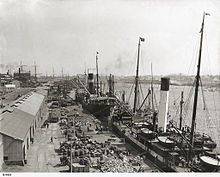Container Origin
Before the invention of container, goods would be loaded onto a vehicle from the factory and taken to a port warehouse where they would be offloaded and stored until loaded into a vessel.
When the vessel arrived, they would be moved to the side of the ship along with other cargo to be lowered or carried into the hold and packed by dock workers. The ship might call at several other ports before off-loading a given consignment of cargo. Each port visit would delay the delivery of other cargo. Delivered cargo might then have been offloaded into another warehouse before being picked up and delivered to its destination.
The process was so messy and time bounded that makes shipping a goods become costly.Time become unreliable for the Multiple handling and delays.
Containerization has its origins in early coal mining regions in England beginning in the late 18th century.
In 1766 James Brindley designed the box boat 'Starvationer' with 10 wooden containers, to transport coal from Worsley Delph (quarry) to Manchester by Bridgewater Canal.
The Liverpool and Manchester Railway in the United Kingdom was one of these. "Simple rectangular timber boxes, four to a wagon, they were used to convey coal from the Lancashire collieries to Liverpool, where they were transferred to horse-drawn carts by crane." Originally used for moving coal on and off barges, "loose boxes" were used to containerize coal from the late 1780s, at places like the Bridgewater Canal.
The Liverpool and Manchester Railway in the United Kingdom was one of these. "Simple rectangular timber boxes, four to a wagon, they were used to convey coal from the Lancashire collieries to Liverpool, where they were transferred to horse-drawn carts by crane." Originally used for moving coal on and off barges, "loose boxes" were used to containerize coal from the late 1780s, at places like the Bridgewater Canal.
In 1795, Benjamin Outram opened the Little Eaton Gangway, upon which coal was carried in wagons built at his Butterley Ironwork. The horse-drawn wheeled wagons on the gangway took the form of containers, which, loaded with coal, could be transshipped from canal barges on the Derby Canal, which Outram had also promoted.
By the 1830s, railroads on several continents were carrying containers that could be transferred to other modes of transport.
By the 1840s, iron boxes were in use as well as wooden ones. Early in 1900s closed container boxes are designed for goods transportation between road and rail.Those are maybe the first shipping containers in the world by iron. We start journey with iron box(Container).
During World War II, the Australian Army used containers to help more easily deal with various breaks of gauge in the railroads. These non-stackable containers were about the size of the later 20-foot ISO container and perhaps made mainly of wood.
ISO started his journey : In London, in 1946, 65 delegates from 25 countries meet to discuss the future of International Standardization. In 1947, ISO officially comes into existence with 67 technical committees (groups of experts focusing on a specific subject).
ISO started his journey : In London, in 1946, 65 delegates from 25 countries meet to discuss the future of International Standardization. In 1947, ISO officially comes into existence with 67 technical committees (groups of experts focusing on a specific subject).
In 1968, ISO publishes its first standard on freight containers. Freight and packaging is one of the areas where ISO has been particularly active, changing the way goods travel across the world.


Comments
Post a Comment